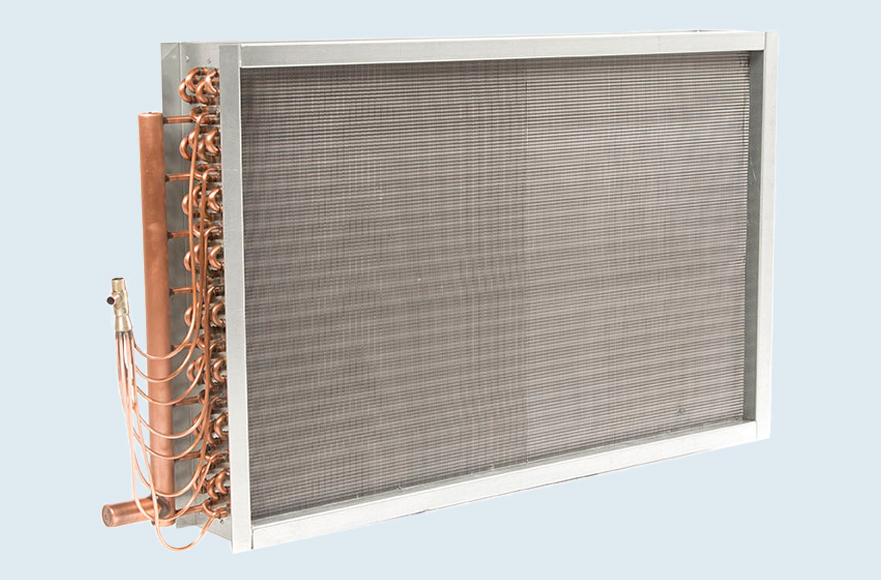DX Cooling Coil Split Circuitry – Why and How It Works

A typical air conditioning system using refrigeration requires control at intermediate loads to properly function and operate through the entire load requirements from highest to lowest. This is the reason why evaporator coils have two or more circuits that match the unloading or compressor cycling on the condenser-compressor side of the system.
For any AC system to work properly, the first consideration is to size the equipment at its highest load and a 10% safety margin above that tonnage. No AC system should be grossly oversized because they operate on absorption of heat into the refrigerant. If this heat is lacking, it will be difficult to control your unit through the intermediate loads.
Evaporator coils in typical AC systems are used to cool and dehumidify. Unlike a chilled water coil system, the refrigerant DX coil cools the supply air directly versus having it cool the water which then cools the supply air. When there are maximum loads, the entire DX evaporator coil can be energized and used. However, maximum load days are few and AC is still needed. Not every day is 90- or 95-degrees F, but cooling may still be required as far down as 60 degrees F. This all depends on factors such as heat loads on the sunny sides of buildings or other heat producers. Let’s assume the tonnage at maximum load conditions is 30 tons. If the temperature drops to 78 degrees, the tonnage required might now be 15 tons. A DX evaporator coil must be able to function at both temperatures.
If you only had one circuit in a coil and the tonnage was halved, the compressor-condenser side could have the suction temperature drop from 45 to 32 degrees. When you look at this side of the system, the suction temperature falls as the tonnage falls. If you run a system and it gets to 32 degrees F. or below, you would get frost on the finned tube pack. Over time, ice accumulates and air passing across the coil would be drastically reduced. Over an extended period of time, the system would shut down or compressor failure would occur.

For many years there were two split circuits to deal with intermediate loads. They were 1) face split and 2) row split. With face split, the top half of the coil is one circuit and the bottom half is the second circuit. Normally they would be equal in tonnage. If the total system is 30 tons, each circuit would be 15 tons. The drawback with a face split is that one operating circuit is dehumidifying and the other isn’t. Air travels to the path of least resistance, and more air may pass over the closed circuit because it isn’t wet like the other circuit. It’s hard to control face split.
Row splitting is better because the entire face is used for each circuit. However, the tonnage for a row split is not 50% of the rows. In other words, if I have a 4-row coil and split it to 2 rows and 2 rows, it’s not a 50/50 performance split. The first 2 rows are 70%, and the last 2 rows are 30%. If a 6-row coil is split, the first 2 rows are close to 50%, and the last 4 rows are the remaining 50%. When using row split, it may be virtually impossible to control and have 50/50 circuits.
A newer circuitry called intertwined circuity has been used and manufactured for the last 20 years. You may see the term interlaced, but they mean the same thing. It’s easy to explain how intertwined circuity is better than either face or row split. All the even tubes in the coil are one circuit, and all the odd tubes are the other circuit. Example: Assume there is a 20 tubes high x 4 row DX evaporator coil. Tubes 1,3,5 etc. in all rows are one circuit and 2,4,6 etc. in each row are the other circuit. With this circuitry arrangement, the full face is used regardless of the circuits in use (both, one or the other). This means a better and more even airflow and a better dehumidifying process. Each circuit has its own distributor and expansion valve.
DX systems are all about the initial engineering design, along with the proper selections and operation after installation. Oversizing is actually worse than under sizing a system. The proper sizing of coils, distributors, and expansion valves is required to create a system that operates properly and efficiently during all load periods. REMEMBER: Clean and efficient condenser coils are required for a smooth operation. Condenser coils are almost always sized for heat of rejection but not much of a service factor. If coils become dirty and condenser air flow falls because of the extra resistance, compressor failures are sure to follow.
Southwest Coil represents USA Coil & Air exclusively in the Southwestern Region. Together, we have been in the business of supplying DX evaporator coils for all types of split systems and refrigerant types for 4+ decades. If you have an old face or row split design that’s never worked properly, we can replace it with an intertwined circuited coil which will often erase your operating problems. We also have expedited schedules for those urgent coil problems.


